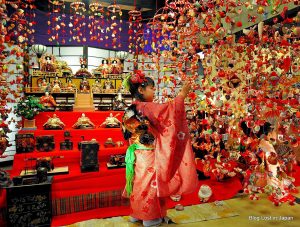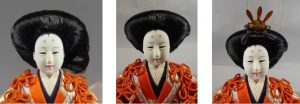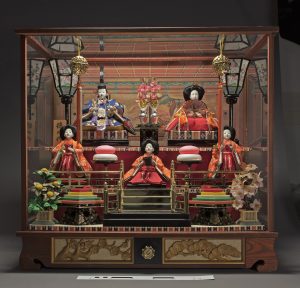March ’20
Hinamatsuri Doll Display
March’s ‘Object of the Month’ is a Hinamatsuri Doll Display from the Oriental Museum collections.

This Japanese Hinamatsuri doll set portrays a wedding ceremony between an Emperor and Empress, with attending servants, food items and blossoming trees. The doll set is surrounded by a display case which is stored in the original cardboard box. The item has remained in storage at the Oriental Museum, since its donation in 2017 by Mr Lloyd Wright. The display case was gifted to him from a student during his time teaching in Japan.

Traditionally dolls and objects were individual items, expertly handcrafted from fine materials such as silk and china. Hinamatsuri doll sets have changed over time, coinciding with the advent of mass production methods and explosion in plastic manufacturing post WW2. Consequently, displays began to be mass produced by department stores in the 1950’s rather than being individually hand crafted. With the downscaling of apartment sizes during the same time, space became a valuable commodity and so small one to three tiered Hinamatsuri displays became the norm. The value of the set and the number of tiers denotes the wealth of a family. Handcrafted sets with china dolls with up to 7 tiers cost upwards of $5,000, while plastic sets of only one to three tiers cost approximately $500. This Hinamatsuri display is a fine example of the mass produced cheaper sets.
The display was mass-produced in Japan, which is indicated by its accession history. It was most likely produced in the Kanto region which can be perceived by the fact the Emperor is situated on the left-hand side of the display (from the viewers perspective) as this is a signature of this region.

The festival of Hinamatsuri is often referred to as Girls Day or Dolls Day and is celebrated annually on the auspicious date of 3rd March. Towards the end of February, Hinamatsuri doll sets are arranged by girls aged between one and ten, aided by female family members. The Hinamatsuri dolls, called Hina Nyonga, are not intended for play, and instead are personified as vessels which embody the families prayers for the health, happiness and long life of their daughters and should be treated with great respect.
This festival of Hinamatsuri is steeped in history and significance for the Japanese people. It has been dated back to the Heian Period (794 to 1185 AD), and dolls are still depicted wearing traditional Heian costume, which this Hinamatsuri display is a modern example of.
Conservation
The display was initially cleaned using a synthetic brush and a museum vacuum on low suction to remove dust and dirt, this was especially useful for the textile surfaces.

Dampened cotton swabs of deionised water and Synperonic A7 were used on the plastic surfaces to remove the surface dirt as it was the only solvent that would not damage the original material. The plastic surfaces were then treated using swabs of pure deionised water to remove any surfactant residues. Any remaining moisture was quickly absorbed away using a microfibre cloth to minimise the exposure of the plastic to the water.

The faces of the dolls were stained yellow on the foreheads and nose. A small test was performed on a less obvious area to see if deionised water had any adverse effect on the unidentified material which the face and neck were constructed from. No adverse effects were seen so a gentle and tentative cleaning of the faces was employed using a cotton swab and deionised water. The water appeared to have no adverse effect on the painted hair, eyelashes, spots or lips of the dolls. The staining was reduced overall, but not completely eradicated as this would have required a firmer clean which could have caused loss of the detailing and features present.
There were a number of pieces that required re-adhering to the display, however as their old adhesive had failed this would require removal before any further adhesive could be applied. Initially the old adhesive was attempted to be removed using swabs of deionised water as this would be least damaging to the plastic components. When this proved insufficient for the plastic components, mechanical means had to be employed.

Once the old adhesive had been removed from the various objects, a new adhesive was required to reattach all the pieces in their original position. Polyvinyl acetate (PVAc) was chosen as it would not react with any of the materials present, it was reversible in water, would cure reasonable quickly and clear, and would be stable for a long period.

Initially the glass in the display case was cleaned with a 50:50 mixture of ethanol and deionised water with a few drops of Synperonic A7 which was applied to the glass using a microfibre cloth. Any residue from the surfactant was then removed using only deionised water in the same manner. Adhesive tape was removed from the front panel (which had been used to keep the front panel from hinging open during transport) and any sticky residue was removed using the same two solutions and cotton swabs.

The fractured glass in the top pane had to be re-adhered and so a suitable adhesive was sought. As Hxtal NYL-1 has a similar refractive index to glass, this was deemed the most appropriate option. The two pieces of glass were held together using small sections of tape and then the adhesive was applied to the break and drawn into the break using capilliary action. The missing pane of glass was replaced with new glass specially cut by a glaziers; it has a similar refractive index as the original glass and is not visually intrusive. The components were then reassembled so the Hinamatsuri display can be shown at the Oriental Museum every year on Girls Day.
Stay tuned for next month’s object!
